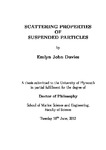Scattering Properties of Suspended Particles
| dc.contributor.supervisor | Nimmo-Smith, Alex | |
| dc.contributor.author | Davies, Emlyn John | |
| dc.contributor.other | School of Biological and Marine Sciences | en_US |
| dc.date.accessioned | 2013-07-17T15:10:39Z | |
| dc.date.available | 2013-07-17T15:10:39Z | |
| dc.date.issued | 2013 | |
| dc.date.issued | 2013 | |
| dc.identifier | 10057491 | en_US |
| dc.identifier.uri | http://hdl.handle.net/10026.1/1577 | |
| dc.description.abstract |
Effective monitoring and modelling of the marine environment is of importance to both the general public and the scientific community, but relies on the ability to obtain accurate measurements of suspended particle characteristics. Many instruments for measuring particles rely on optical and acoustic scattering from the particles and use this information to infer a particle size and concentration. However, assumptions such as spherical particles of a known composition are widely used, both in measurement technology and in numerical modelling. Various imaging techniques have shown great variability in the shape, size and composition of marine particles when measured within their natural environment. Subsequently, there is substantial uncertainty in the response of light scattering instruments to this diverse range of particles. In this study, a holographic camera was modified to simultaneously record in-focus images of marine particles with their forward angle scattering characteristics. This was achieved by combining both laser scattering and transmissometry with digital holography. The results from this system were compared with theoretical models of scattering from spherical particles within the intended size range of both instruments (15-500microns), with particle size information from both techniques agreeing well during these idealised conditions. The combined holographic and light scattering system was then used to investigate the response of the LISST-100 (Sequoia Scientific Inc.) to spherical particles with diameters extending beyond that intended by the instrument 250microns for type-B and 500microns for type-C derivatives), but that have been observed in-situ with imaging methods. This revealed an aliasing of single large particles into multiple smaller particles during the inversion of LISST-100 scattering into a particle size distribution. For spheres greater than the type-C instrument range, the inversion of scattering produces particle volume distributions that peak at varying sizes between 250-400microns. This key finding highlights the need for care to be taken when interpreting particle size distributions from the LISST-100 when there is potential for particles outside of its range limit. Natural particles, extracted from coastal waters, were then recorded by the combined laboratory system. These complex particles produced highly variable scattering properties which were contaminated by asymmetrical features within the azimuthal plane. This observation of strong azimuthal asymmetry is of concern for both measurements and models of optical properties that assume a symmetrical scattering function for natural particle populations. The azimuthal asymmetry in scattering contributed to additional variability in the response of the instrument in comparison to the holographic camera, which was also subjected to apparent particle break-up via segmentation during image processing. A discussion of holographic imaging and laser diffraction for characterising particles in-situ forms the final part of this thesis, which utilises data from a magnified holographic system that covers the same size range of the LISST-100. This final analysis demonstrated the need for future technology to accurately measure size distributions over a much larger range of sizes than is currently possible (e.g. <2microns to 1000microns). In summary, three key factors were identified to cause an increase in the apparent number of small particles reported by the LISST-100: 1) contamination from scattering of particles larger than the intended size range of the instrument; 2) a decrease in refractive index (particle composition); 3) additional scattering from small sub-components of particle geometry. The standard holographic camera systems are capable of accurately obtaining particle size and concentration measurements that are comparable to other techniques such as the LISST-100. However, in situations where background illumination is poor, errors in the image processing routines can cause an apparent particle break-up due to incorrect binarisation. Despite this, the holographic method provides a unique and powerful mechanism that enables images of particles to be analysed within the context of their in-situ environment. | en_US |
| dc.description.sponsorship | NERC | en_US |
| dc.language.iso | en | en_US |
| dc.publisher | University of Plymouth | en_US |
| dc.subject | Holography | |
| dc.subject | Particle size | |
| dc.subject | Sediment | |
| dc.subject | Optics | |
| dc.subject | Scattering | |
| dc.subject | Laser diffraction | en_US |
| dc.title | Scattering Properties of Suspended Particles | en_US |
| dc.type | Thesis | |
| plymouth.version | Full version | en_US |
| dc.identifier.doi | http://dx.doi.org/10.24382/3873 |
Files in this item
This item appears in the following Collection(s)
-
01 Research Theses Main Collection
Research Theses Main


